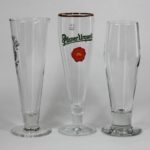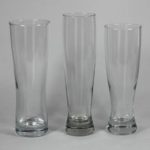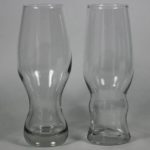
The tulip Pint is also known as the Irish Imperial Pint or Guinness Glass. While you’re likely to see this glass a lot it’s not quite as versatile as some of the other styles of pint glass.
This glass gets its name from it’s familiar tulip shape. Unlike shorter stemmed tulips its top lacks a flared mouth and instead ends with walls pointing straight up. These glasses are almost always 20 ounces but some mild variation can occur.
Benefits of the Tulip Pint Glass
Like other pint glasses the most immediate benefit is volume. The Imperial Irish Pint holds about 20 ounces which is plenty of space for a large pour while still leaving a generous amount of space for a beer’s head.
With it’s smaller base and more pronounced bulb some people might also find it a little easier to hold than the nonic pint.
These glasses also provide a good look at a beer’s deeper colors while the wide mouth helps support head retention. Of course it also helps with taking large sips of “Nitro” beers that have thick frothy heads. For nitros keep a napkin handy ’cause a milk beer-mustache is in your future.
Other Notes
There are smaller versions of this glass floating around in various different sizes. Many will be branded “Guinness” but will only be 16 ounces.
You want to be looking for a 20 ounce glass. Due to a quirk in how we deal with fluid ounces there might even be some small variation there but that’s OK. A true imperial pint will measure just over 19 US ounces and for our purposes that’s pretty OK.
Just avoid the 16 ounce ones.
What Beer Goes with a Tulip Pint Glass?
Most people know this glass as a Guinness Glass so that’s a good jumping off point. Irish Stouts are so tied to this glass it almost feels wrong to drink them in anything else. The same goes for Irish Ales.
After that any beer billing itself with the term “Nitro” is a safe bet. The wide mouth at the top of the glass makes a beer’s creamy head and body that much more tantalizing.
This glass also works well as a utility glass for any ales or lagers poured from a large bottle. Personally, I’d avoid lagers and keep them in something like a large pilsner or a stange but it’s not a huge deal. You’ll have to go back to the fridge to retrieve the bottle more often but it’s worth it.
I’d also avoid beers with really active carbonation, sour beers, or beers with higher ABVs. Those are better suited to other glasses.
Where Can I Buy Tulip Pint Glasses / Irish Imperial Pints?
These are going to be some of the easiest glasses for you to get a hold of. Every liquor store, box store, and some supermarkets are going to have them. Just check for either a 20 ounce volume marker or the imperial crown either on the bottom or lip of the glass.
They’re also a common inclusion in most craft beer glass sampler boxes.



